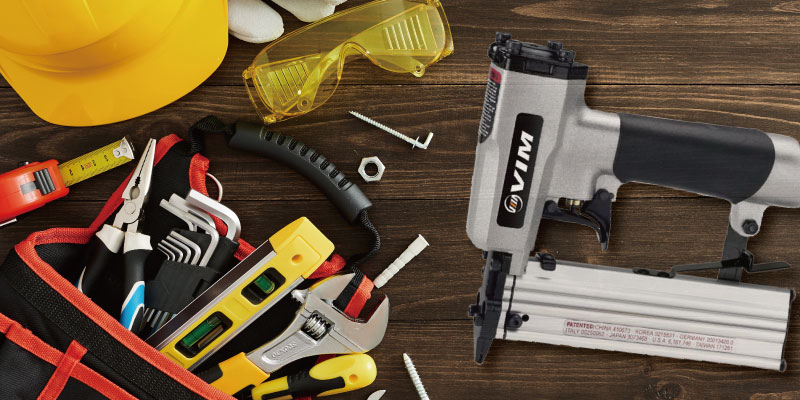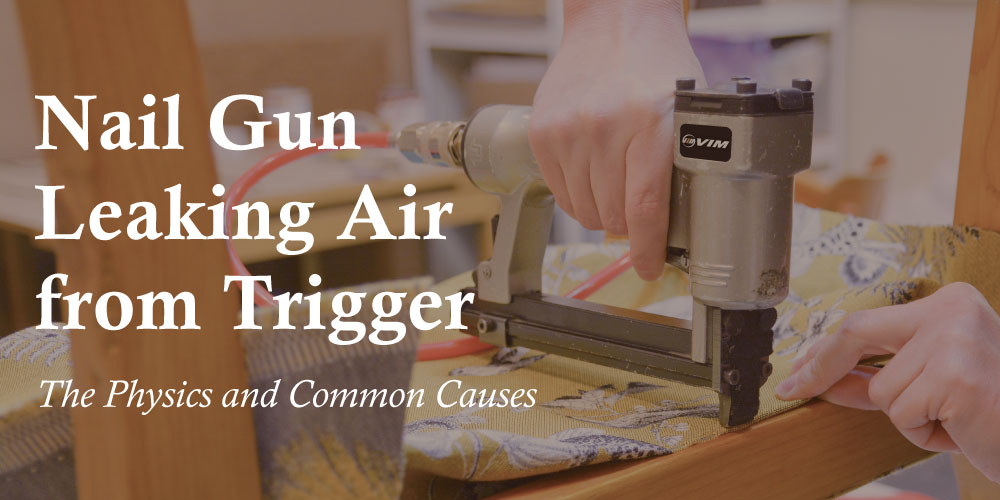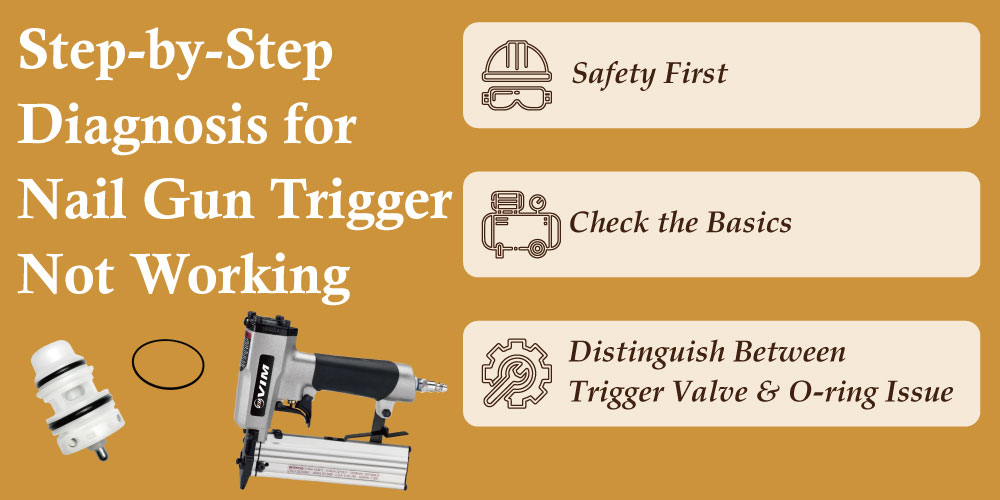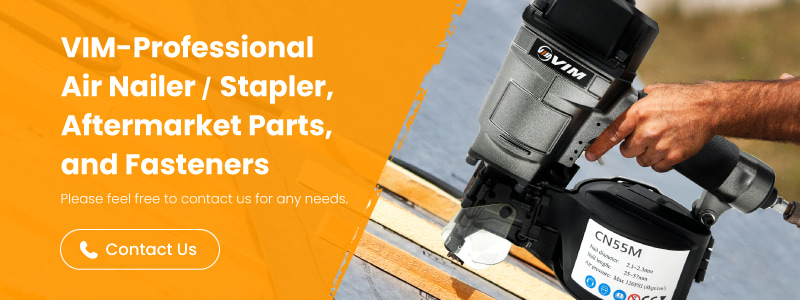- Home
- INSIGHT
- Spare Parts
- Nail Gun Leaking Air from Trigger? Step-by-Step Fix & Prevention
Nail Gun Leaking Air from Trigger? Step-by-Step Fix & Prevention

A nail gun is only as good as its trigger. When your nail gun trigger isn’t working as it should, or when you notice your nail gun leaking air from trigger, the loss of performance can be frustrating — and costly. Air leaks reduce driving power, slow down your workflow, and can even shorten the lifespan of the tool.
This article walks you through how a pneumatic trigger works, why leaks reduce power, the most common mechanical causes, and how to diagnose and prevent these problems. Whether you’re a professional contractor or a DIY enthusiast, knowing how to identify and fix these issues will help you keep your nail gun performing at its best.
Nail Gun Leaking Air from Trigger – The Physics and Common Causes
 How a Pneumatic Trigger Works
How a Pneumatic Trigger Works
A pneumatic nail gun trigger is the control point for the air pressure that powers the tool. When you pull the trigger, it opens a small internal valve that allows compressed air from the compressor to rush into the driver assembly — the mechanism that propels the nail.
- Airflow pathway
The journey begins at the air compressor, which stores air under pressure. That air flows through the air hose, enters the nail gun’s main body, and reaches the trigger valve. When the trigger is pressed, the valve opens, directing a precise burst of air into the driver assembly. This rapid pressure surge pushes the driver blade downward, striking the nail into the material. - Seals and O-rings
Along this pathway, several rubber O-rings and seals are strategically placed to keep air from escaping. They ensure that nearly all the compressed air energy reaches the driver in a controlled burst. If these components are worn, cracked, or dried out, the seal breaks. Instead of all the air going into the driver, some leaks out — often through the trigger area — leading to a noticeable hiss, slower firing speed, and nails that don’t sink fully.
Why Trigger Leaks Reduce Power
When a nail gun trigger leaks air, part of the compressed air meant to drive the nail escapes before it reaches the driver assembly. Even a small nail gun leaking air from trigger can seriously affect both performance and tool longevity. This causes two major problems:
- Loss of air pressure before activation
In a properly functioning nail gun, the trigger seals hold back the full pressure until the exact moment you fire. A leak means some of that pressure bleeds out early, so the driver blade starts its stroke with less force behind it. - Reduced driving force → Nails not sinking fully
Because the driver blade isn’t powered by the full burst of compressed air, it may fail to push the nail completely into the work surface. This often leaves nails sticking out, forcing you to refire or finish the job manually. Over time, repeated underpowered strikes can also stress internal parts like the driver blade and bumper, leading to more frequent breakdowns.
Common Mechanical Causes of Air Leaks Around the Trigger
When a nail gun trigger develops a leak, the problem usually comes down to worn or damaged components inside the trigger valve assembly. These are the most common causes:
- Worn or damaged o-rings
O-rings are small rubber seals that keep compressed air contained until the trigger is pulled. Over time, they can crack, dry out, or flatten, allowing air to escape and producing a steady hiss around the trigger area. - Cracked trigger valve housing
The housing holds the trigger valve components in place. If it develops cracks from impact, over-tightening, or material fatigue, air can leak past the seals and reduce the tool’s overall efficiency. - Faulty trigger valve cap
The cap seals the end of the trigger valve. If it’s warped, damaged, or not seated properly, it can create small gaps where air escapes, often causing inconsistent firing performance. - Loose or misaligned trigger valve gage, pilot valve, or pins
These parts must be precisely aligned to maintain an airtight seal. If they shift or are installed loosely, air can leak around them, leading to intermittent hissing or weak firing power. - Damaged trigger valve stem
The stem is the moving component that opens and closes the valve when the trigger is pulled. If it’s bent, worn, or broken, it won’t seal properly, causing continuous air leakage whether the nail gun is firing or idle.
Identifying Leak Patterns by Sound and Bubble Test
Pinpointing the source of a nail gun leaking air from trigger can often be done without opening the tool. Using the sound-and-bubble method — listening for air leaks and performing a simple bubble test — is one of the fastest ways to determine whether your nail gun trigger is suffering from a minor seal issue or a more serious mechanical problem inside the valve assembly.
- Steady hissing
A constant, unchanging hiss usually means a damaged seal or worn O-ring that can no longer hold pressure. The leak will persist whether or not the trigger is pressed. - Intermittent hiss
If the hissing sound comes and goes, it may indicate debris lodged in the valve or partial seal damage. The leak might only appear when the trigger is moved or the gun is in certain positions. - Bubble test
Mix dish soap with water and apply it around the trigger area using a small brush or spray bottle:- Continuous bubbles
A constant leak, often caused by a faulty seal, cracked valve housing, or damaged O-ring. - Bubbles only when firing
A trigger valve problem, such as a worn stem or cap that leaks only under pressure.
- Continuous bubbles
【Extended reading: Air Nailer Troubles? 6 Trigger Issues and How to Fix Them】
Step-by-Step Diagnosis for a Nail Gun Trigger Not Working
 Safety First
Safety First
- Disconnect the air supply
Bleed any remaining pressure from the nail gun before touching the Nail Gun Trigger or valve area. - Wear eye/hand protection
Safety goggles and gloves: boring, but mandatory.
Check the Basics
- Air hose & fittings
Run your fingers along the hose and quick-connects; look/feel for cracks, loose couplings, or a wobbly plug. Reseat the coupler until it clicks firmly. A leaky line can mimic a nail gun trigger not working issue. - Compressor pressure & flow
Verify regulator PSI meets the tool spec (often 70–120 PSI) and that the compressor can supply enough CFM. Low PSI/CFM = weak or no firing, even if everything else is perfect. - Inline filter/lubricator
A clogged filter starves air; a dry tool accelerates seal wear. Add a few drops of pneumatic oil to the air inlet and try again.
Distinguish Between a Trigger Valve and O-Ring Issue
- Listen at the trigger
- Constant hiss at the trigger
Likely worn or damaged O-rings/seals, causing a nail gun leaking air from trigger even when not firing. - Silent at the trigger (no hiss)
Move to the next checks.
- Constant hiss at the trigger
- Press the trigger or depress the safety nose
- Hiss appears only when the trigger is pressed
Often a trigger valve issue (stem, cap, or housing damage). - No hiss but no firing
Could be the trigger valve not opening, a blocked passage, or mechanical linkage problem.
- Hiss appears only when the trigger is pressed
- Bubble test for confirmation
- Apply soapy water around the trigger area.
- Continuous bubbles = Constant leak (usually seal or housing issue).
- Bubbles only when firing = Trigger valve problem.
Preventing Trigger Problems and Air Leaks
 Keeping your nail gun trigger in good condition not only prevents unexpected downtime but also extends the overall life of your nail gun. Regular maintenance and a few good habits can help you avoid both nail gun trigger not working and nail gun leaking air from trigger issues.
Keeping your nail gun trigger in good condition not only prevents unexpected downtime but also extends the overall life of your nail gun. Regular maintenance and a few good habits can help you avoid both nail gun trigger not working and nail gun leaking air from trigger issues.
Lubrication and Cleaning
- Daily lubrication
Add 2–3 drops of pneumatic tool oil into the air inlet before starting work. This keeps O-rings flexible and prevents premature wear. - Clean the trigger area
Dust, wood chips, and debris can work their way into the trigger valve and cause leaks. Use compressed air to blow out dirt at the end of each day.
Environmental Factors Affecting Trigger Life
- Moisture
Keep your nail gun in a dry place. Water in the air supply can cause rust and swelling in seals, leading to leaks. - Extreme cold
Cold temperatures can harden O-rings and make them more likely to crack. Store tools in a moderate environment when possible. - Dusty conditions
High dust environments require more frequent cleaning and inspection of the trigger assembly.
Scheduled Maintenance
- Inspect seals and O-rings
Replace them every 6–12 months in heavy-use situations. - Check the trigger valve
Look for cracks, misalignment, or signs of wear before starting major projects. - Test for leaks regularly
A quick listen at the trigger and an occasional bubble test can catch problems early.
Conclusion
A well-functioning nail gun trigger is critical for consistent, powerful performance. By understanding the airflow pathway, recognizing the signs of a leak, and following a systematic diagnosis process, you can resolve most nail gun trigger not working and nail gun leaking air from trigger issues before they become major repairs. Preventive maintenance — from regular lubrication to environmental protection — is the key to extending your tool’s lifespan.
If your trigger components are worn or damaged beyond repair, it’s worth replacing them with high-quality parts. At VIM, we supply precision-made trigger valves, O-rings, and repair kits compatible with leading nail gun brands, ensuring airtight performance and reliable operation. Contact us today to get the right parts for your tool and keep your projects running smoothly.
Feel free to contact us with your requirements—we are here to assist you!
Article Classification
Recent Articles
- The 2 Leading Nail Gun Bumper Materials You Don’t Want to Overlook
- Maximize Tool Performance: 4 Smart Ways to Pick the Best Air Tool Fittings
- What Happens When a Driver Blade Fails? Lessons from the Paslode 901078
- Nail Gun Leaking Air from Trigger? Step-by-Step Fix & Prevention
- What Technicians Don’t Tell You: 6 Moves to Fixing Driver Units and Restoring Nailers

